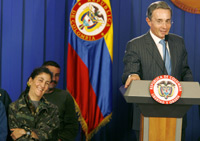Colombia - background
Farc's long war and Betancourt's captivity
Article published on the 2008-07-03 Latest update 2008-07-10 13:11 TU
1950s: Dissident liberal and communist party members, disgruntled with the hard-line military dictatorship in power, leave mainstream politics to form agrarian/communist "republics". The largest is 1,000-member Marquetalia, located in the Andean plains. It is allegedly led by Manuel Marulanda, an 18-year-old peasant.
1964: The Colombian military, after taking a loan from the US, launches a napalm attack against Marquetalia. Survivors of the attack regroup to form Bloque Sur (Southern Bloc), and declare war on Colombia.
1966: Southern Bloc expands its military agenda to form Fuerza Armadas Revolucionarias de Colombia (Farc). Marulanda remains commander-in-chief of the militia.
1970s-1980s: Farc establishes its own schools, health care, judicial system and agricultural-based economy.
1984: Farc and the Colombian government sign the La Uribe peace accords. Farc forms Union Patriotica (UP), a legitimate political party. UP members gain seats in the government. The party stresses anti-corruption policies, and becomes the target of right-wing death squads and paramilitaries. At least 3,000 UP members disappear during this period. Farc takes up the gun again, maintaining that violence is the only way to gain political influence.
1996-1998: Farc gains a series of major military victories over the Colombian army, including taking over the Las Delicias military base. Dozens of Colombian troops are taken hostage.
2001: Farc's violent acts, including hijacking planes, kidnapping, murder and narco-trafficking, increase. Former Culture Minister Consuelo Araujonoguera is abducted and murdered. Venezuelan President Hugo Chavez announces he is mounting efforts to free Colombian soldiers held hostage by Farc.
2002: Presidential candidate Ingrid Betancourt, who advocates peace talks, is kidnapped and taken into the jungle in February. In October Farc demands the release of all of its jailed fighters in exchange for the politicans and police it is holding. Right-wing candidate Alvaro Uribe is elected president.
2003: Farc kills a provincial governor, a former defence minister and eight soldiers held hostage when the army fails to rescue them.
2006: Uribe re-elected president, after the constitution is amended to allow him a second term in office.
2007: Farc issues a statement saying they will turn three hostages over to Chavez after Uribe's government ends the Venezuelan president's efforts as a negotiator. In December the deal fails as both the Colombian government and Farc accuse each other of trying to kill the deal.
2008: In January two hostages are freed, raising hopes for the dozens still in captivity.
February: Farc releases four Colombian hostages to Chavez.
March: Farc says that the murder of one of their top leaders in Ecuador has jeopardised the hostage exchange.
March: Colombia offers cash and reduced jail terms to the rebels if Betancourt is freed.
April: French President Nicolas Sarkozy calls for her release, saying she is close to death and suffering from various ailments. He sends a plane and medical team to French Guyana, but the team is not allowed to meet the hostages.
June: Chavez urges Farc guerillas to release all hostages from the camps.
July: Colombian forces rescue Betancourt, three Americans, and 11 Colombian soldiers from Farc. Some 100 hostages remain in captivity.










